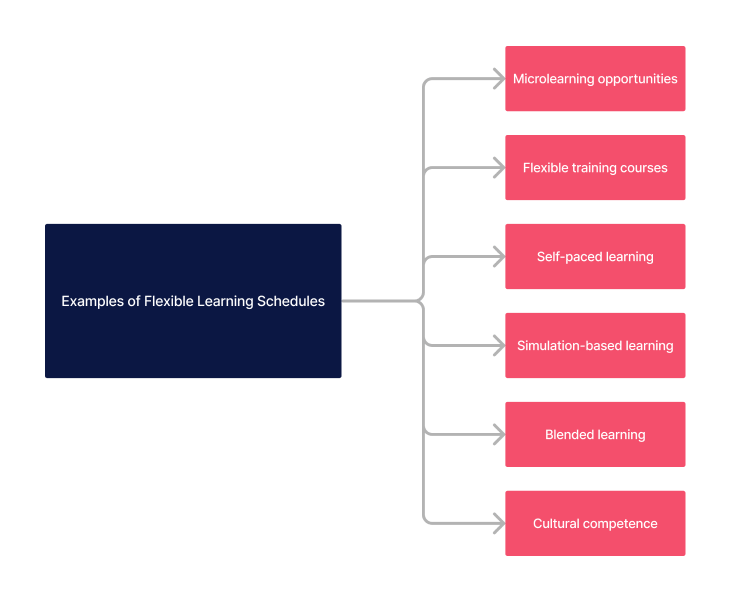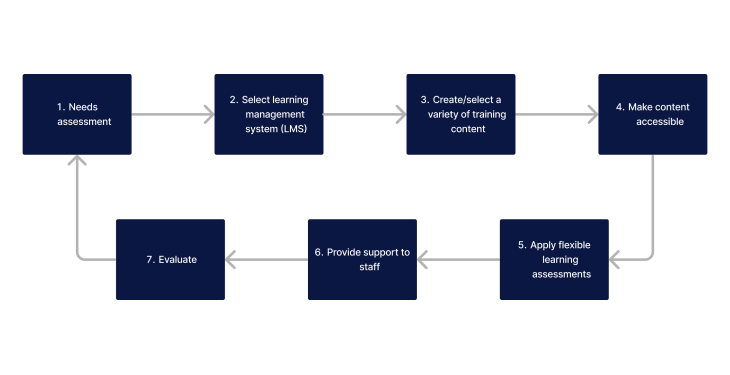What Is Flexible Learning?
Flexible learning is an educational approach tailored to meet the dynamic needs of individuals within the healthcare sector. It allows learners, especially health professionals, to engage with educational content at their own pace, from any location, and at any time that suits their schedules. This adaptability is crucial in the healthcare environment, where working hours can vary.
What are Flexible Learning Schedules?
Flexible learning schedules go beyond just asynchronous learning. They often feature a blend of self-paced and scheduled learning activities. Scheduled activities might include live webinars, real-time discussions, and interactive sessions that offer direct engagement with instructors and peers, providing a structured learning experience without sacrificing flexibility. This blend ensures that while professionals have the freedom to learn at their own pace, they also have opportunities for live interaction and engagement, which are vital for a comprehensive learning experience.
Examples of Flexible Learning schedules in Healthcare

Each of these examples demonstrates how flexible learning schedules in healthcare are essential for accommodating the demanding and unpredictable schedules of health services workers, ensuring they have access to necessary training without compromising their service delivery.
- Microlearning opportunities: Short, focused training sessions designed for quick consumption, ideal for health professionals with limited time. These can cover a wide range of topics, from patient care techniques to updates on healthcare policies.
- Flexible Training Courses: Designed to support workers in updating their skills and knowledge through a mix of online, evening, and weekend sessions.
- Self-paced learning: These modules can be accessed at any time, allowing learners to digest complex information at their own pace.
- Simulation-based Learning: By engaging in flexible learning, healthcare professionals can directly impact the quality of care provided to patients. Schedule in learning opportunities on the shifts they are working.
- Blended Learning: Combines online theoretical learning with scheduled practical sessions. This approach accommodates the varied schedules, allowing them to balance their clinical responsibilities with professional development.
- Cultural Competence: With a diverse population in Australia, healthcare professionals need to be culturally competent. Self-directed learning allows them to explore and understand different cultural perspectives and healthcare needs autonomously.
Why is Flexible Learning in Healthcare important
Flexible learning in healthcare is not just a convenience; it's a necessity. The healthcare sector is characterised by constant evolution, with new treatments, technologies, and health information emerging regularly. This forever changing landscape requires health professionals to continually update their knowledge and skills.
Furthermore, healthcare professionals face unique challenges, including long and unpredictable work hours, high-stress environments, and the emotional toll of patient care. Flexible learning schedules address these challenges by allowing learners to engage with educational content when it best fits into their complex schedules, thus avoiding additional stress or burnout
How to Implement Flexible Learning Schedules

Implementing flexible learning schedules involves understanding the specific learning needs of healthcare workers, leveraging a robust learning management system (LMS), and providing a variety of training courses that support different learning styles and professional requirements.
Below are some example of how you can start to implement flexible learning schedules within you organisation:
- Needs Assessment: Begin by conducting surveys or interviews to understand the specific learning needs and preferences of healthcare workers. This assessment should identify gaps in knowledge and skills, preferred learning formats, and any barriers to accessing education.
- Learning Management System (LMS): Choose a robust LMS that supports flexible learning options, such as asynchronous learning, mobile access, and multimedia content. The LMS should be user-friendly and capable of tracking progress, managing courses, and delivering a range of interactive learning experiences.
- Variety of Training Courses: Create training courses that cater to different learning styles and professional roles within the healthcare sector. Include a mix of online lectures, interactive modules, real-world simulations, and self-assessment tools to engage learners effectively.
- Content Accessibility: Make sure that learning materials are accessible on various devices, including smartphones, tablets, and desktop computers. This ensures that healthcare workers can access training materials anytime, anywhere, fitting learning into their busy schedules.
- Flexible Assessment: Provide varied assessment methods, such as online quizzes, project-based assessments, and virtual simulations, allowing learners to demonstrate their understanding in ways that best suit their learning style and schedule.
- Support: Implement support systems, such as online forums, chat support, and mentorship programs, to assist learners throughout their educational journey. Regular feedback on progress and performance helps keep learners motivated and on track.
- Evaluate: Regularly review the flexible learning schedules and course offerings based on feedback from healthcare workers and changes in the healthcare industry. This ensures that the training remains relevant, effective, and aligned with the needs of healthcare professionals.
Strategies to Implement Flexible Learning Schedules
To effectively implement flexible learning schedules, education and learning development managers should:
- Consult with health professionals to identify learning needs and preferences.
- Use a learning management system (LMS) to deliver compliance courses and other healthcare training efficiently.
- Offer a mix of synchronous and asynchronous learning options, including online training.
- Ensure training is accessible on multiple devices to accommodate learning on-the-go.
- Regularly update content to reflect the latest health system and department of health guidelines.
Advantages and Disadvantages of Flexible Learning Schedules
Flexible learning schedules offers a range of benefits but also comes with challenges.
| Advantages | Disadvantages |
|---|---|
| Increased accessibility enables health professionals to access training materials anytime. | Requires high self-motivation and discipline |
| Supports work-life balance | The lack of face-to-face interaction can lead to feelings of isolation among learners, which contrasts with the benefits of personalised learning. |
| Flexibility to learn anytime and anywhere | Difficulty in assessing the quality of resources |
| Develops strong analytical skills to navigate challenges and evaluate information independently. | Lack of formal assessment, making it challenging to gauge progress or receive constructive feedback. |
| Personalised learning experiences | Creating content that caters to the varied learning styles and technological capabilities of a diverse workforce can be challenging. |
Want a healthcare LMS that can support flexible learning schedules?
Contact Ausmed today and see how we can support your organisation!
Related Resources
- What Is the Role of Microlearning in Healthcare Education?
- LMS in Healthcare: The Roles, Benefits and Pros and Cons
- How Can I Use Peer Feedback to Enhance Learning?
- What Are the Key Learning Analytics Metrics?
- What Are the Benefits of Blended Learning in Healthcare?
- What Are the Best Practices for Learning Accessibility?
- Guide to Compliance Training (for Healthcare Managers)
- How to Manage an Effective Staff Training Program
- Identifying Skills Gaps with Learning Analytics
- A Guide to Personalised Learning in Healthcare
- Research Spotlight: Motivation for Self-directed Training
Conclusion
The transition towards flexible learning schedules in healthcare represents a significant shift in how education and professional development are approached within the sector. This model offers numerous advantages, including increased accessibility, personalized learning experiences, efficiency in compliance maintenance, and support for work-life balance. These benefits are particularly crucial in the fast-paced and ever-evolving field of healthcare, where the need for continuous, up-to-date education intersects with the demands of patient care and personal well-being.
References
Coyne, E, Frommolt, V, Rands, H, Kain, V & Mitchell, M, 2018, Simulation videos presented in a blended learning platform to improve Australian nursing students' knowledge of family assessment', Nurse education today, vol. 66, pp.96-102.
De Gagne, JC, Park, HK, Hall, K, Woodward, A, Yamane, S & Kim, SS, 2019, 'Microlearning in health professions education: scoping review', JMIR medical education, vol. 5, no. 2, p.e13997.Halcomb, E & Ashley, C, 2017, 'Australian primary health care nurses most and least satisfying aspects of work, Journal of clinical nursing, vol. 26 no.3-4, pp.535-545.
Reeves, S, Fletcher, S, McLoughlin, C, Yim, A & Patel, K, 2017, 'Interprofessional online learning for primary healthcare: findings from a scoping review', BMJ open, vol. 7, no. 8, p.e016872.
Sozmen, EY, 2022, 'Perspective on pros and cons of microlearning in health education', Essays in Biochemistry, vol. 66, no. 1, pp.39-44.



